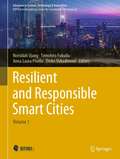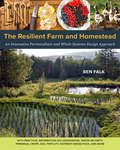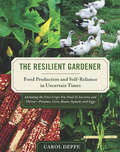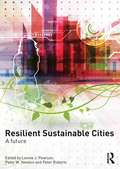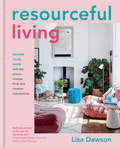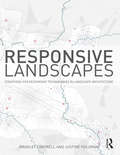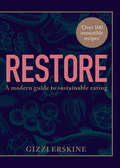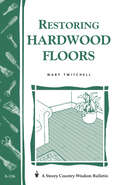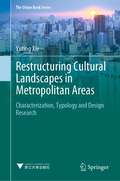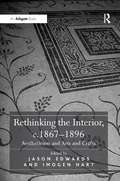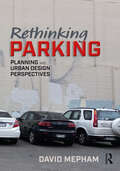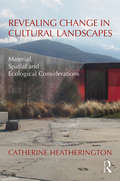- Table View
- List View
Resilient and Responsible Smart Cities: Volume 1 (Advances in Science, Technology & Innovation)
by Norsidah Ujang Tomohiro Fukuda Anna Laura Pisello Dinko VukadinovićThis book focuses on the ways in which resiliency can foster the transformation of cities. There is a growing need for our cities to be transformed into “smart” cities; in this regard, tremendous efforts are called for in order to face the environmental challenges that play a major role in the creation or transformation of cities and environments. This book covers a broad range of applications and approaches that are “smart” and “resilient,” which, when combined, offer much more flexibility concerning the future of our cities. Consequently, this simple combination, which is producing sweeping changes around the globe, has attracted considerable attention from scholars and decision-makers alike.
The Resilient Farm and Homestead: An Innovative Permaculture and Whole Systems Design Approach
by Ben FalkThe Resilient Farm and Homestead is a manual for developing durable, beautiful, and highly functional human habitat systems fit to handle an age of rapid transition. Ben Falk is a land designer and site developer whose permaculture-research farm has drawn national attention. The site is a terraced paradise on a hillside in Vermont that would otherwise be overlooked by conventional farmers as unworthy farmland. Falk’s wide array of fruit trees, rice paddies (relatively unheard of in the Northeast), ducks, nuts, and earth-inspired buildings is a hopeful image for the future of regenerative agriculture and modern homesteading. The book covers nearly every strategy Falk and his team have been testing at the Whole Systems Research Farm over the past decade, as well as experiments from other sites Falk has designed through his off-farm consulting business. The book includes detailed information on earthworks; gravity-fed water systems; species composition; the site-design process; site management; fuelwood hedge production and processing; human health and nutrient-dense production strategies; rapid topsoil formation and remineralization; agroforestry/silvopasture/grazing; ecosystem services, especially regarding flood mitigation; fertility management; human labor and social-systems aspects; tools/equipment/appropriate technology; and much more, complete with gorgeous photography and detailed design drawings. The Resilient Farm and Homestead is more than just a book of tricks and techniques for regenerative site development, but offers actual working results in living within complex farm-ecosystems based on research from the “great thinkers” in permaculture, and presents a viable home-scale model for an intentional food-producing ecosystem in cold climates, and beyond. Inspiring to would-be homesteaders everywhere, but especially for those who find themselves with “unlikely” farming land, Falk is an inspiration in what can be done by imitating natural systems, and making the most of what we have by re-imagining what’s possible. A gorgeous case study for the homestead of the future.
The Resilient Gardener: Food Production and Self-Reliance in Uncertain Times
by Carol DeppeScientist/gardener Carol Deppe combines her passion for organic gardening with newly emerging scientific information from many fields — resilience science, climatology, climate change, ecology, anthropology, paleontology, sustainable agriculture, nutrition, health, and medicine. In the last half of The Resilient Gardener, Deppe extends and illustrates these principles with detailed information about growing and using five key crops: potatoes, corn, beans, squash, and eggs. In this book you’ll learn how to: •Garden in an era of unpredictable weather and climate change •Grow, store, and use more of your own staple crops •Garden efficiently and comfortably (even if you have a bad back) •Grow, store, and cook different varieties of potatoes and save your own potato seed •Grow the right varieties of corn to make your own gourmet-quality fast-cooking polenta, cornbread, parched corn, corn cakes, pancakes and even savory corn gravy •Make whole-grain, corn-based breads and cakes using the author’s original gluten-free recipes involving no other grains, artificial binders, or dairy products •Grow and use popbeans and other grain legumes •Grow, store, and use summer, winter, and drying squash •Keep a home laying flock of ducks or chickens; integrate them with your gardening, and grow most of their feed. The Resilient Gardener is both a conceptual and a hands-on organic gardening book, and is suitable for vegetable gardeners at all levels of experience. Resilience here is broadly conceived and encompasses a full range of problems, from personal hard times such as injuries, family crises, financial problems, health problems, and special dietary needs (gluten intolerance, food allergies, carbohydrate sensitivity, and a need for weight control) to serious regional and global disasters and climate change. It is a supremely optimistic as well as realistic book about how resilient gardeners and their vegetable gardens can flourish even in challenging times and help their communities to survive and thrive through everything that comes their way — from tomorrow through the next thousand years. Organic gardening, vegetable gardening, self-sufficiency, subsistence gardening, gluten-free living.
Resilient Sustainable Cities: A Future
by Leonie J. Pearson Peter W. Newton Peter RobertsUrbanization is occurring at an unprecedented rate; by 2050 three quarters of the world’s people will live in urban environments. The cars we drive, products we consume, houses we live in and technology we use will all determine how sustainable our cities will be. Bridging the increasing divide between cross-disciplinary academic insights and the latest practical innovations, Resilient Sustainable Cities provides an integrated approach for long term future planning within the context of the city as a whole system. In the next 30 years cities will face their biggest challenges yet, as a result of long term, or ‘slow burn’ issues: population growth will stretch to the breaking point urban infrastructure and service capacity; resource scarcity, such as peak oil; potable water and food security, will dramatically change what we consume and how; environmental pressures will change how we live and where and; shifting demographic preferences will exacerbate urban pressures. Cities can’t keep doing what they’ve always done and cope – we need to change current urban development to achieve resilient, sustainable cities. Resilient Sustainable Cities provides practical and conceptual insights for practitioners, researchers and students on how to deliver cities which are resilient to ‘slow burn’ issues and achieve sustainability. The book is organized around three overarching themes: pathways to the future innovation to deliver the future leadership and governance issues The book includes a variety of perspectives conveyed through international case studies and examples of cities that have transformed for a sustainable future, exploring their successes and failures to ensure that readers are left with ideas on how to turn their city into a resilient sustainable city for the future.
Resilient Sustainable Cities: A Future
by Leonie Pearson Peter Newton Peter RobertsUrbanization is occurring at an unprecedented rate; by 2050 three quarters of the world’s people will live in urban environments. The cars we drive, products we consume, houses we live in and technology we use will all determine how sustainable our cities will be. Bridging the increasing divide between cross-disciplinary academic insights and the latest practical innovations, Resilient Sustainable Cities provides an integrated approach for long term future planning within the context of the city as a whole system. In the next 30 years cities will face their biggest challenges yet, as a result of long term, or ‘slow burn’ issues: population growth will stretch to the breaking point urban infrastructure and service capacity; resource scarcity, such as peak oil; potable water and food security, will dramatically change what we consume and how; environmental pressures will change how we live and where and; shifting demographic preferences will exacerbate urban pressures. Cities can’t keep doing what they’ve always done and cope – we need to change current urban development to achieve resilient, sustainable cities. Resilient Sustainable Cities provides practical and conceptual insights for practitioners, researchers and students on how to deliver cities which are resilient to ‘slow burn’ issues and achieve sustainability. The book is organized around three overarching themes: pathways to the future innovation to deliver the future leadership and governance issues The book includes a variety of perspectives conveyed through international case studies and examples of cities that have transformed for a sustainable future, exploring their successes and failures to ensure that readers are left with ideas on how to turn their city into a resilient sustainable city for the future.
Resourceful Living: Revamp Your Home With Key Pieces, Vintage Finds And Creative Repurposing
by Lisa DawsonIt's often thought that restyling your space comes with a hefty price tag and unavoidable waste. But in Resourceful Living, award-winning interiors blogger Lisa Dawson shows how, with a little creativity, you can revamp your home with existing pieces, vintage finds and key purchases. The clever ideas in this beautiful book cover:- The most important ways we use our homes, from eating to sleeping, living and working.- The Basics of steering clear of interiors 'fast fashion', multi-purposing furniture and making the most of what you have.- Styling Your Home with simple solutions for re-imagining each room, from gallery walls to home bars, repainted storage to retro accessories.Including her top ten key vintage buys and tips for in-store and online thrifting, Lisa's inspiring advice shares the fun of creative sourcing as a more sustainable way to keep your home feeling fresh.'Resourceful Living feels like reading a recipe book, not only because of the delicious interiors images, but because of the simple ingredients and easy methods that are shared to achieve beautiful living spaces for yourself.' Melanie Sykes'I've been a long-time fan and follower of Lisa's interiors tips. This book really is super practical as well as beautiful - perfect for anyone looking to be more interiors savvy.' Rachel Khoo
Responsive Landscapes: Strategies for Responsive Technologies in Landscape Architecture
by Justine Holzman Bradley E CantrellThe sensing, processing, and visualizing that are currently in development within the environment boldly change the ways design and maintenance of landscapes are perceived and conceptualised. This is the first book to rationalize interactive architecture and responsive technologies through the lens of contemporary landscape architectural theory. Responsive Landscapes frames a comprehensive view of design projects using responsive technologies and their relationship to landscape and environmental space. Divided into six insightful sections, the book frames the projects through the terms; elucidate, compress, displace, connect, ambient, and modify to present and construct a pragmatic framework in which to approach the integration of responsive technologies into landscape architecture. Complete with international case studies, the book explores the various approaches taken to utilise responsive technologies in current professional practice. This will serve as a reference for professionals, and academics looking to push the boundaries of landscape projects and seek inspiration for their design proposals.
Responsive Landscapes: Strategies for Responsive Technologies in Landscape Architecture
by Justine Holzman Bradley E CantrellThe sensing, processing, and visualizing that are currently in development within the environment boldly change the ways design and maintenance of landscapes are perceived and conceptualised. This is the first book to rationalize interactive architecture and responsive technologies through the lens of contemporary landscape architectural theory. Responsive Landscapes frames a comprehensive view of design projects using responsive technologies and their relationship to landscape and environmental space. Divided into six insightful sections, the book frames the projects through the terms; elucidate, compress, displace, connect, ambient, and modify to present and construct a pragmatic framework in which to approach the integration of responsive technologies into landscape architecture. Complete with international case studies, the book explores the various approaches taken to utilise responsive technologies in current professional practice. This will serve as a reference for professionals, and academics looking to push the boundaries of landscape projects and seek inspiration for their design proposals.
Restore
by Gizzi Erskine‘Gizzi’s recipes are creative, seriously satisfying and packed full of flavour.’ BBC Good Food ‘One of the most talked-about chefs of 2020 … a trailblazing approach to eating better and more sustainably without skimping on flavour’ GQ ‘Recipes that are good for the earth and good for the soul.’ The Times
Restore: Ancient Remedies from the Modern Kitchen
by Lizzie KingBoost your resilience and combat the rigours of modern living.For anyone who is suffering from insomnia, Lizzie King has just the cure. After a hideous clock-change week that left her family devoid of rest, she turned to her knowledge as a nutritional health coach and created a 'sleep tight' smoothie. Restore is filled with 100 such ingenious recipes for you and your home – from tonics that ease hay fever and balms for anxiety, syrups for avoiding the seasonal lurgies or coping with a sick bug, to fizzing bath bombs, edible face masks, lickable kitchen sprays and more. There's even a few especially for your dog.You don't need chemicals to create an effective remedy or cleaner, nor do you have to be naturally crafty: the recipes are fuss-free, and many of the ingredients are likely to be in your pantry already.Our world is glittering with natural ingredients, many that have been used for millennia as remedies without damaging side-effects for us or our planet. Restore will help you to thrive in optimal health.
Restore: The first book from The Repair Shop’s woodworking expert
by Will KirkThe art of caring for the things you love ...Caring for the items you love around the home is easier - and more rewarding - than you think. In his first book, The Repair Shop's resident woodworking expert Will Kirk takes you on a tour of the basics of wood care and restoration, from first steps and quick fixes around the home to getting stuck into larger projects over a weekend.Whether you are fixing something you have had for years or upcycling something new, Restore shows you how simple and joyful woodworking can be, from fixing knicks and stains and making small repairs, to everyday hacks you can use to help care for your furniture.Restore teaches us how to save pieces of furniture from the scrap heap and appreciate the craftsmanship behind the objects we use every day. Encouraging us all to slow down and appreciate the beauty of woodcraft through easy, accessible projects - which anyone can start working on at home!
Restoring Hardwood Floors: Storey's Country Wisdom Bulletin A-136 (Storey Country Wisdom Bulletin)
by Mary TwitchellSince 1973, Storey's Country Wisdom Bulletins have offered practical, hands-on instructions designed to help readers master dozens of country living skills quickly and easily. There are now more than 170 titles in this series, and their remarkable popularity reflects the common desire of country and city dwellers alike to cultivate personal independence in everyday life.
Restoring the Wild: Creation, Restoration and Management
by Donald MacIntyreDrawing on the latest botanical science and opinion, and real-world practical knowledge, this richly illustrated practical guide is essential reading for anyone interested in creating and restoring species-rich meadows and wild vegetation, whether it is a garden, woodland, field, urban space or simply to gain a greater understanding of the history and renovation of Britain and Ireland's rich and diverse meadows – an intrinsic part of our natural and cultural heritage. In this book, the UK's leading wild meadow seed producer, Donald MacIntyre, provides expert advice on all areas of the creation, restoration and management of meadowland, including a directory with detailed accounts of the 220-plus species for habitat restoration and creation in the British Isles. Foreword by Sara Oldfield OBE 'Donald's generosity in sharing his knowledge through this inspiring and practical publication will enable wider production of good quality seed to support and enhance biodiversity whether in wild areas, meadows, farmland, urban parks and gardens, and along transport routes.' Sara Oldfield OBE
Restructuring Cultural Landscapes in Metropolitan Areas: Characterization, Typology and Design Research (The Urban Book Series)
by Yuting XieThis book introduces a ten-year-long design research project in the Yangtze River Delta (YRD), China, based on international cooperation studios, design workshops, a Ph.D. thesis, and concrete practice in China, Germany, and the Netherlands. This research adapts the existing methods of Landscape Character Assessment (UK), Historic Cultural Landscape Elements (Germany), and Dutch Polder Typology to mapping, describing, and classifying landscape character areas and types at the three scales of regional, municipal, and local. Furthermore, to connect research with design, we developed a typological approach of generating specific measures for the networked polder landscape. This research bridges the gap of a missing landscape characterization method for the conservation, transformation, and critical reconstruction of historic cultural landscapes in a metropolitan context. The book is intended for graduate students, researchers, and practitioners interested in the topics of cultural landscape in transition, methods for landscape characterization and typology, and a research-by-design approach in interdisciplinary projects of landscape architecture, urbanism, and regional planning.
Rethinking Design and Interiors: Human Beings in the Built Environment
by Shashi CaanThe world and the people living in it are increasingly and rapidly being affected by environmental and technological changes. It is imperative that the design profession addresses these developments with a new way of thinking. This book points the way for the design of interiors in this newly complex world and will be indispensable for students, practitioners and theoreticians.The book is divided into four chapters that explore aspects of the human experience of the interior, from man’s earliest search for shelter to an outline of past and current thinking on design, psychology and well-being. An epilogue looks at such future concerns as population growth and sustainability and suggests how the design profession can confront these challenges.Rethinking Design and Interiors is a fascinating exploration of how art and science can come together for the benefit of those who inhabit the built environment.
Rethinking The Interior, C. 1867-1896: Aestheticism And Arts And Crafts
by Jason Edwards Imogen HartFrom Aesthetes in Africa to the cultural history of the teapot, this collection addresses the topic of "eclectic" relationships in Victorian decorative art. Rethinking the Interior, c. 1867-1896 argues that no firm demarcation exists between Aestheticism and Arts and Crafts, the two movements examined here. The volume addresses the complex and temporary character of interiors, and challenges the identification of nineteenth-century interiors as exclusively female or family spaces.
Rethinking Parking: Planning and Urban Design Perspectives
by David MephamFor much of the past century, we have viewed the issue of parking from the driver’s seat. It follows that key narratives about parking reaffirm the immediate needs of the driver. A consequence of this approach is a failure to understand the significant damage that parking causes to the destination. That damage is amplified by ‘cheap, easy’ parking at the expense of place and access outcomes. Viewing parking from an urban planning and design perspective highlights different issues and opportunities. Five perspectives are offered: Place – If we gave drivers all the parking they wanted, the destination would not be worth visiting. Politics – Parking is intensely territorial, emotional, and prone to populism, and this is a barrier to strategic and sustainable parking reform. Policy – Parking tends to be focused on the ‘me, here and now’ needs of the driver at the expense of bigger picture and longer term policy objectives. Price – Subsidized parking exists behind opaque pricing mechanisms. In contrast, a transparent accounting of costs is a vehicle for strategic parking reform. Professional practice – Parking is a significant land-use issue, located at the juncture of transport and urban planning and design. Improving urban parking outcomes requires an integrated and collaborative planning process. An alternative view of parking is timely as new technologies and economies fundamentally change everything we understand about parking. A potential paradigm shift is in the making. Rethinking Parking provides a pathway to a better parking/place balance and access to destinations worth visiting. It is valuable reading for students and professionals engaged in transport, planning, urban access, and design.
Rethinking Parking: Planning and Urban Design Perspectives
by David MephamFor much of the past century, we have viewed the issue of parking from the driver’s seat. It follows that key narratives about parking reaffirm the immediate needs of the driver. A consequence of this approach is a failure to understand the significant damage that parking causes to the destination. That damage is amplified by ‘cheap, easy’ parking at the expense of place and access outcomes. Viewing parking from an urban planning and design perspective highlights different issues and opportunities. Five perspectives are offered: Place – If we gave drivers all the parking they wanted, the destination would not be worth visiting. Politics – Parking is intensely territorial, emotional, and prone to populism, and this is a barrier to strategic and sustainable parking reform. Policy – Parking tends to be focused on the ‘me, here and now’ needs of the driver at the expense of bigger picture and longer term policy objectives. Price – Subsidized parking exists behind opaque pricing mechanisms. In contrast, a transparent accounting of costs is a vehicle for strategic parking reform. Professional practice – Parking is a significant land-use issue, located at the juncture of transport and urban planning and design. Improving urban parking outcomes requires an integrated and collaborative planning process. An alternative view of parking is timely as new technologies and economies fundamentally change everything we understand about parking. A potential paradigm shift is in the making. Rethinking Parking provides a pathway to a better parking/place balance and access to destinations worth visiting. It is valuable reading for students and professionals engaged in transport, planning, urban access, and design.
Rethinking the Concept of Waste and Mass Consumption: Preserving Resources through Reuse, Repair and Recycling (Routledge Studies in Sustainability)
by Richard WaiteThis book presents hard facts, drawn from extensive research, to highlight our unsustainable consumption of the Earth’s resources and the limitations of the UK’s current management of waste and recycling.Setting out a bleak picture of a world in which we are literally consuming our planet, the book explores the psychological, economic and capitalist drivers behind this behaviour. Controversially, the book examines the drawbacks of the current approach adopted by many local authorities on the kerbside collection of recyclable materials, as well as the UK governments’ strategic approaches to household recycling, including the lack of UK- wide infrastructures for packaging reuse, and for product repair and recycling. It challenges the whole concept of waste, leading to a proposed new strategy for the management of household waste, including a simplified household collection system, the introduction of an incineration tax and the banning of all household waste exports. The author proposes reconceptualising waste as unwanted but valuable material and argues that the responsibility for facilitating reuse, repair and recycling, rests with manufacturers who must start designing with the end in mind.Given the current economic climate, and a dampening of the green agenda within UK politics, the book provides a much- needed call for critical discourse on how, and how much, we consume and sets out clear, practical solutions for change. The book will be of interest to manufacturers, retailers, consumers, local authorities, policy makers, students and professionals looking to reduce our impact on the environment.
Rethinking the Concept of Waste and Mass Consumption: Preserving Resources through Reuse, Repair and Recycling (Routledge Studies in Sustainability)
by Richard WaiteThis book presents hard facts, drawn from extensive research, to highlight our unsustainable consumption of the Earth’s resources and the limitations of the UK’s current management of waste and recycling.Setting out a bleak picture of a world in which we are literally consuming our planet, the book explores the psychological, economic and capitalist drivers behind this behaviour. Controversially, the book examines the drawbacks of the current approach adopted by many local authorities on the kerbside collection of recyclable materials, as well as the UK governments’ strategic approaches to household recycling, including the lack of UK- wide infrastructures for packaging reuse, and for product repair and recycling. It challenges the whole concept of waste, leading to a proposed new strategy for the management of household waste, including a simplified household collection system, the introduction of an incineration tax and the banning of all household waste exports. The author proposes reconceptualising waste as unwanted but valuable material and argues that the responsibility for facilitating reuse, repair and recycling, rests with manufacturers who must start designing with the end in mind.Given the current economic climate, and a dampening of the green agenda within UK politics, the book provides a much- needed call for critical discourse on how, and how much, we consume and sets out clear, practical solutions for change. The book will be of interest to manufacturers, retailers, consumers, local authorities, policy makers, students and professionals looking to reduce our impact on the environment.
Rethinking the Interior, c.1867-1896: Aestheticism and Arts and Crafts (PDF)
by Jason Edwards Imogen HartFrom Aesthetes in Africa to the cultural history of the teapot, this collection addresses the topic of "eclectic" relationships in Victorian decorative art. Rethinking the Interior, c.1867-1896 argues that no firm demarcation exists between Aestheticism and Arts and Crafts, the two movements examined here. The volume addresses the complex and temporary character of interiors, and challenges the identification of nineteenth-century interiors as exclusively female or family spaces.
The Return of Nature: Sustaining Architecture in the Face of Sustainability
by Preston Scott Cohen Erika NaginskiThe Return of Nature asks you to critique your conception of nature and your approach to architectural sustainability and green design. What do the terms mean? Are they de facto design requirements? Or are they unintended design replacements? The book is divided into five parts giving you multiple viewpoints on the role of the relations between architecture, nature, technology, and culture. A detailed case study of a built project concludes each part to help you translate theory into practice. This holistic approach will allow you to formulate your own theory and to adjust your practice based on your findings. Will you provoke change, design architecture that responds to change, or both? Coedited by an architect and a historian, the book features new essays by Robert Levit, Catherine Ingraham, Sylvia Lavin, Barry Bergdoll, K. Michael Hays, Diane Lewis, Andrew Payne, Mark Jarzombek, Jean-Francois Chevrier, Elizabeth Diller, Antoine Picon, and Jorge Silvetti. Five case studies document the work of MOS Architects, Michael Bell Architecture, Steven Holl Architects, George L. Legendre, and Preston Scott Cohen.
The Return of Nature: Sustaining Architecture in the Face of Sustainability
by Preston Scott Cohen Erika NaginskiThe Return of Nature asks you to critique your conception of nature and your approach to architectural sustainability and green design. What do the terms mean? Are they de facto design requirements? Or are they unintended design replacements? The book is divided into five parts giving you multiple viewpoints on the role of the relations between architecture, nature, technology, and culture. A detailed case study of a built project concludes each part to help you translate theory into practice. This holistic approach will allow you to formulate your own theory and to adjust your practice based on your findings. Will you provoke change, design architecture that responds to change, or both? Coedited by an architect and a historian, the book features new essays by Robert Levit, Catherine Ingraham, Sylvia Lavin, Barry Bergdoll, K. Michael Hays, Diane Lewis, Andrew Payne, Mark Jarzombek, Jean-Francois Chevrier, Elizabeth Diller, Antoine Picon, and Jorge Silvetti. Five case studies document the work of MOS Architects, Michael Bell Architecture, Steven Holl Architects, George L. Legendre, and Preston Scott Cohen.
Revealing Change in Cultural Landscapes: Material, Spatial and Ecological Considerations
by Catherine HeatheringtonThis book explores different design approaches to revealing change within a landscape, and examines how landscape designers bring together the cultural context of a specific place with material, spatial and ecological considerations. Revealing Change in Cultural Landscapes includes case studies such as Gilles Clément’s Jardin du Tiers-Paysage in France, the Brick Pit in Sydney, Australia and Georges Descombes’ Renaturation of the River Aire in Switzerland to uncover the insights of designers. In doing so, Catherine Heatherington considers the different ways designers approach the revealing of change and how this informs a discussion about people’s perceptions and understanding of landscape. With over 100 images and contributions from Jacky Bowring, Dermot Foley and Krystallia Kamvasinou, this book will be beneficial for students of landscape and landscape architecture, particularly those with an interest in how landscapes change over time and how this is perceived by both designers and visitors.
Revealing Change in Cultural Landscapes: Material, Spatial and Ecological Considerations
by Catherine HeatheringtonThis book explores different design approaches to revealing change within a landscape, and examines how landscape designers bring together the cultural context of a specific place with material, spatial and ecological considerations. Revealing Change in Cultural Landscapes includes case studies such as Gilles Clément’s Jardin du Tiers-Paysage in France, the Brick Pit in Sydney, Australia and Georges Descombes’ Renaturation of the River Aire in Switzerland to uncover the insights of designers. In doing so, Catherine Heatherington considers the different ways designers approach the revealing of change and how this informs a discussion about people’s perceptions and understanding of landscape. With over 100 images and contributions from Jacky Bowring, Dermot Foley and Krystallia Kamvasinou, this book will be beneficial for students of landscape and landscape architecture, particularly those with an interest in how landscapes change over time and how this is perceived by both designers and visitors.
